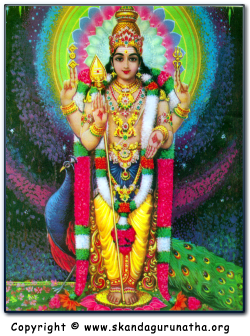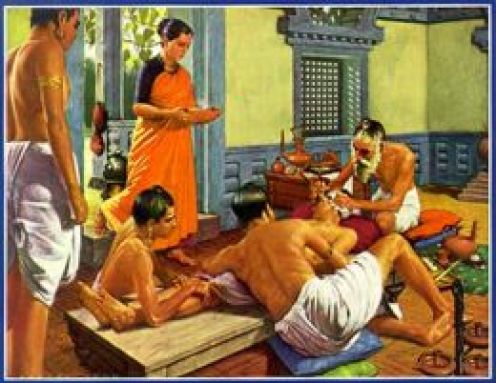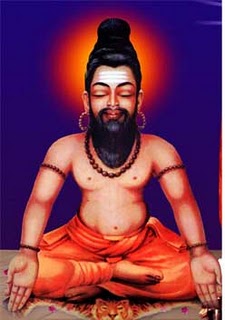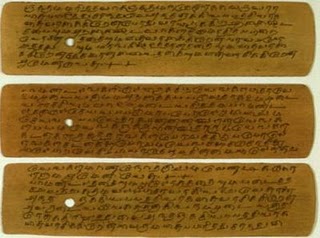
There has often been some confusion over the Shaivite Natha and Siddha traditions in India, that are supposed to have originated from the pre-Vedic peoples.
However, looking back to the Vedic texts, we find only a continuity in these traditions.
Agastya, the founder of many of these traditions in Southern India, is a Rig Vedic Aryan Seer, who was hence well-versed in Sanskrit. In the South, he is connected with the creation of the Tamil language, along with Murugan, the war-God known in the North as Skanda.
Murugu, Murugan the Tamil term means “beauty”and is reflected in pure Sanskrit terms such as:
MaNjiman (Sanskrit)
Marut (Beauty), Marutvan (Sanskrit)
Murti (Beauty) (Sanskrit)
Maughda (Charm, beauty) (Sanskrit)
The Maruts themselves are the sons of Rudra-Shiva, himself associated with Agni in the Rig Veda, and are lead by Agni, as Marutvan, which is perhaps from where the Tamil “Murugan” having the same meaning, derives.
Moreover, in the Vedic texts, Agni the Fire-God is also called Brahmanaspati (Lord of Prayer) and is hence associated with Vak or Speech itself – the Sanskrit language, thus having similar connections to the origin of the Tamil language of the South.
The Rig Veda itself commences with “agnimiLe” (I praise Agni) – “iLe” itself possessing a rare Sanskrit sound that is a common feature found in Dravidian languages of the South, but faded in use in later Sanskrit in the North – again showing the Agni-origin of both languages and peoples from a Vedic era.
Rudra-Shiva, in the Shatapatha Brahmana text of the Vedic era (VI.1.3.8-19) tells us that he was first born as a Kumara (boy) and was given nine names: Rudra, Sarva, Ugra, Pashupati, Asani, Bhava, Mahadeva, Ishana and Kumara, his ninth name.
Now, this connects Murugan-Agni with his importance in later Hinduism and also the association of him as a Supreme Deity – an avatar and son of the god Shiva.
Agni as Karttikeya, or son of the Seven Virgins the Krittikas, derives from the Vedas, where he is commonly associated with the Seven Maidens as his mothers.
His Nine Forms are also important, as we recall the tradition of the Nava Nathas or Nine Nathas in the North, a Yogic tradition of which began with Shiva and his nine manifestations as a Yogi. The idea for this, and the symbolism at least, hence derives from the Vedic era.
Tara is also a goddess later associated with Shiva as a Kumara or Boy. According to legend, Shiva drank the poison form the churning of the sea of milk, and was nursed by the goddess in the form of Tara who breast-fed him Amrita or nectar, until he recovered.
Such a tale is recounted in the Rig Veda ((V.2.1-2), where his names Kumara and Guha (hidden) first come into being, and the imagery of the mother-goddess nursing the baby Agni is described, as also giving him “amrita” – relating to the Tara episode.
Nilakantha is the name of Shiva in this form, meaning “blue-necked”, a name which also occurs in the second oldest Vedic text, the Taittiriya Samhita (IV.1.5) under the term “Nilagriva” meaning the same.
Other things associated with Shiva and the Yogic traditions in India are the great death mantra (Mahamrityunjaya), which asks the great god to deliver us from mortality to immortality. This mantra appears as a mantra of the Sage Vasishtha (brother of Agastya) in the Rig Veda (VII.59.12).
Agni-Shiva is also described in the Rig Veda as the Father, Mother as Saviour of humanity (VI.1.5), which reminds us of his androgynous nature in later Hinduism, where Shiva becomes both the Mother and Father – Shakti and Shiva in manifestation, and how both are inseparable.
When we look at the Vedic Rishis, and their mantras, associations with later Siddha and Natha traditions, and also their powers in the Epics such as Ramayana and Mahabharata, we begin to see how they are much like the Nathas and Siddhas of later times also.
Agastya for example, teaches Rama the Solar-King in the Ramayana text in the science of Brahmastra (the weapon chant). These astras are found everywhere in Vedic texts, especially in the texts such as Mahabharata, where the mentors of the Aryan cousins, Kauravas and Yadavas are taught these by Drona, Bhishma and Karna.
These arte part of the Vedic martial arts systems, which are traced back to Parshurama, historically, Rama Jamadagni, the son of Vedic Rishi Jamadagni of the Bhargava (Brighu) Seer family. Interestingly, in southern regions such as Kerala, he and his Vedic martial arts traditions are still honoured.
The Rig Vedic Maruts appear to have had this science, as per their description as Seer-warriors, as also the Dhanurvidya (martial science) is described as a Vedic science in the early Upanishads, such as Brihadaranyaka.
The Vedic Gods, such as the Ashwins, the founders of Ayurveda or Vedic Medical Science, are also portrayed like Siddha or Nathas of later times, with their mystical, almost yogic powers.
One verse of the Rig Veda (VII.67.5) asks the Ashwins to assist us in battle with their powers (shaktis) and actually refers to them as Shachipatis or Lords of the Shakti or Power.
The Shakti is the yogi’s power in later Hinduism, and here seeing it appearing as a feminine term also shows it’s importance in relation to the Vedic Gods, and the siddhis (mystical yogic powers), since the Ashwins perform many feats through it.
They make cripples walk (I.117.19) and the blind to see (VIII.68.2), and put together the body of the Seer Shyava that was sliced in three (II.118.24)
and restore the head of Seer Dadhyak’s with that of a horse (I.117.24), in the Rig Veda.
The Queen, Vispala is given a golden left by the Ashwins, after hers is cut off in battle (RV.I.118.8). She is then able to fight again.
If the Vedic Aryans were mere barbarians, then how is it that their military and medical sciences were so advanced? And if the so-called Dravidians possessed these sciences and gave them to the Aryans – why did they not fight the Aryans with them? Moreover – why do the Aryans possess such a Tantric and Yogic culture, from the earliest of stages?
This shows that the two cultures arose from the same culture.
Making a Southern Connection:
The oldest recessions of the Vedas, the Rig Vedic and the Krishna Yajur Vedic (Taittiriya Samhita) are both preserved in Southern India, especially amongst the Nambudiri Brahmins of Kerala, of which also includes the great Adi Shankaracharya (c.500BCE), who reformed Hinduism throughout India, at a time when Buddhism and Jainism were taking control!
These Brahmins, like many in the South, also trace not only their origin, but also the creation of their land-mass to the Vedic Sage Rama Jamadagni (Parshurama), who was mentioned earlier.
There is much in the way of Tantricism in Kerala also, but it is fascinating that Tantra itself appears merely as closer to Rig Vedic Hinduism, also, as noted, surviving to the South, and having reformers as late as Shankara coming from the region. Other Vedic scholars are such as Aryabhatta the famous astrologer, and Bhashkaracharya.
The area is also famed for being ruled by the ancient demon-King Bali, of whom brought down the decent of the Vishnu-avatar Vamana, the drawf, who defeated him. While some may claim that Bali was a non-Arya King defeated by the Aryan god Vishnu, let us first enquire, as to why he would also be the devotee of Vishnu in the first place, and his entire family, including famous grandfather Prahlada also was? As also, his entire family always had Brighu Gurus, one of the oldest Vedic Seer families? Hence, this also connects to why Kerala Brahmins link themselves to Rama Jamadagni, of the Brighu Seers, and his martial sciences, which perhaps grew under the influence of Bali, and other such kings.
Another famous character in the South is Asuramaya (The Wise Asura). He is non other than Ushanas Kavya, the descendant of Brighu-Rishi also. In the South he is revered for being the creator of the sciences of astrology (Jyotish) and Architecture (Stapathya). In the Rig Veda he is also called Tvashtar, the creator-god, and creates the thunderbolt for Indra.
We therefore see that the ancient Natha and Siddha traditions of the South, as also the North, derive from Vedic Hinduism, and that the Northern and Southern peoples derive from the same origins.
It appears however, that the South preserved the older side of the Vedic culture through the Brighu and Agastya Seers, whereas the North took upon newer recessions, such as the Shukla Yajur Veda or White Yajur Veda, through Yajnavalkya.
Yajnavalkya himself, also author of famous texts as Shatapatha Brahmana and the Brihadaranyaka Upanishad, which have yogic and mystic siddha-like sciences everywhere, descends from the older Taittiriya Tradition of the Aruni Rishis. These Aruna Rishis themselves, as the name suggests, seem to have originated in the South for a start, around Arunachala.
We also note that famous Shaivite chants such as Shri Rudram, and Vedic Solar Yoga, lie in the older Taittiriya Samhita also, and also show the later correlation of this area, with Shiva.
Arunachala is also the region of Siddhas and Nathas, who are said to dwell there. Could these be the ancient Aruna Rishis to whom Vedic Seers as Yajnavalkya and others looked back to?
Certainly, it seems to fit with the entire tradition, and shows that the Siddhas and Nathas were merely later versions of the Rishis of ancient Vedic times.
Once again, it further asserts that the Dravidian people are just older “Vedic stock” or the proto-Aryans, as opposed to non-Aryans! In fact, the southern Iyer Brahmins etc. derive from Arya.
The South and the Origin of the Aryan Rishis:
The ancient Tamils of the South tell us of tales of a sunken kingdom that lay to the South-East of India, of which recent Mahabalipuram ruins seem to have shown. This land was known as Kumari Kandam “The Virgin Landmass” or Ilam.
Ancient India was also called Ilavarta (The Land of Ila) by the Vedic Aryans, named after their Protogenitor Ila, the daughter of the first-man, Manu. Manu in this era, is known as Vivasvan or the Solar-Manu (The Vedic religion being solar).
Interestingly, Ila is also a goddess that relates to speech and wisdom in the Rig Veda, and closely associated with Saraswati, the goddess of whom Hindus credit the Vedas, the Sanskrit language and alphabet. Ila-Saraswati is also Vak (speech) in the Vedas.
Recently, we know the Saraswati River has been found, and running through the area identified as the Vedic or Indus Valley civilisation, where the language originated. So then, what is Ila’s connection?
It appears as mentioned earlier with the Agni-speech connection of both Tamil and Sanskrit, that Ila also connects the two, as the older area where the proto-Rig Vedic language (from which Sanskrit and Dravidian tongues arose) and culture came from. The key is also in the term “agnimiLe” which contains the term “ILa” – the older Vedic term for “Ila” in classical Sanskrit, possessing the famous sound found in Dravidian languages.
What is more, Manu (the first Aryan) in Bhagavata Purana (VIII.24.13) is stated to have been a King called Satyavraya from the Dravida province (Southern India) who sailed North to avoid the floods, and to whom the Matysa (fish) incarnation of Vishnu appeared to (even in Shatapatha Brahmana).
Agastya and Brighu Rishis in the Rig Veda, are also portrayed as being put in a kumbha (pot) to escape floods, by their father Varuna, the god of waters. Agastya in Southern tales, also escapes this same southern flood!
Getting back to Manu and Ila, we find in the text Brihadaranyaka Upanishad (VI.4.28) Ila mentioned as 'Maitravaruni' meaning 'daughter of Mitra (Sun) and Varuna (Waters)'- showing she is cognate to both Satyavrata and Vaivasvata and connects the two, and shows the first 'Aryans' or Vedic people came from Southern Indian practices.
Texts as Vishnu Purana and Ramayana also tell us of another King Satyavrata, also known as Trishanku, of whom Seer Vishvamitra gave bodily accession into a heaven the Seer himself created, since he had become an outcaste and Indra rejected him.
This seems related to a flood tale, and also a tale of “New Lands” created from the old lands of Indra, which is perhaps the North and South. Vishvamitra’s Heaven is perhaps the Sarasvati region, and Satyavrata the new King.
Satyavrata is descended from the Solar Dynasty of India and was father of Harischandra, another famous King of ancient India, associated with sacrificing his own son.
This all, also connects the oldest Brighus with the flood, and explains their presence in the region of Southern India. Mahabalipuram in Tamil Nadu, and the rule of King Bali in Kerala in the West, perhaps also relates these events to an older pre-flood era, when this greater land-mass existed, or just after.
That the southern Siddha Yogis were also associated with this culture, and again descended from Agastya etc., and having connections with the Aruna Rishis, shows them as the first of the Rig Vedic Seers and fathers of the Aryan or so-called “Indo-European” peoples themselves!
The fact of the oldest Aryans as Mediterranean peoples:
While these theories contradict the idea that the Aryan peoples were a Nordic race, let us remember that other Aryan peoples such as Keltic peoples of Britain also have more in common with shamanism or “Tantra” and Yoga, showing that the older Aryan culture was of such a type.
This would propose the Kelts as Dravidian peoples, if we believed those subscribing to Aryan-Invasion theories.
The Iranian Zoroastrians also had their magic, and even the term ‘magic’ itself, derives from the “magi” of ancient Iran.
The Greeks, Romans, Iranians and the first people of Britain were also of the darker Mediterranean race, the same as the Hindus of India. If they did come from the South of India, it is natural their skin would lighten in the North, and hence we see the peoples of Northern India resembling the peoples of Southern Europe.
Even today, the people of Wales, the most traditional of the Keltic people, have strong Mediterranean blood in their veins, which has been there from pre-Roman times. This also questions the Aryan-Invasion theory of Nordic peoples in early Britain, as much as it does in India!
Old Irish is also very close to Sanskrit, and shows it as perhaps an earlier offshoot.
The ancient Kelts also called themselves the peoples of Dana or Danu, who is the ancient Vedic goddess who mothered the demons (Danavas), including Vritra, the great serpent. This is also associated with a flood-culture, and shows that the scholarly tale of the Dravidian people of India as “Danavas” and non-Aryan, as completely incorrect!
By race alone however, we can see that the languages of Europe, and the oldest people and civilisation-builders there, were descendants of the Southern peoples of India, categorised as “Dravidians”.
Interestingly, this same Mediterranean race of earlier times that included the Basques, Etruscans and Guanches of Europe, and the Sumerians of the ancient Middle-East share a strong language similarity of ancient Dravidian tongues – showing an even older wave of these people from the region towards the West. This possibly also included, or at least was the origin of the Hamitic people such as the Egyptians, Ethiopians and Somalis of Africa.
We note that their Pyramidal architecture reflects the ancient Vedic Aryan or Dravidian styles and their variants in south east Asia, such as Borodobur in Indonesia. These styles also act as an “intermediate” between the Egyptian in the West and Meso-American styles, with Dravidian, but that is another topic!
Conclusion:
From here we can conclude that the ancient Aryan peoples and Indo-European languages derive from the ancient Indian peoples of India ,that are herein indigenous, and always have been.
The testimony of the similarity of languages, myths and continuity of ideas, and the same ancestor-ship between North and South Indians, as also the dominancy of the Mediterranean race found throughout the ancient Aryan peoples, proves this.
When we think about this however, we recall that the southern Siddha-Nathas and their traditions, the Vedic Rishis and the Keltic Druids all do seem to have been part of an older greater One-World culture!
To deny this is to deny the fact that the ancient Aryan peoples practiced any sort of black or white magic or sacrifice – which was the basis of their entire culture, and from which modern Tantric sacrifices ad practices derive!
It appears that the blunder here is also that scholars have looked to the more materialistic non-Siddha type cultures of Greece, Iran (Persia) and Rome, as opposed to studying other Aryan peoples such as the Kelts, who were more organic and spiritual.
That would naturally link these people with ancient India, and their origin in the now sunken regions of the South of India, which will hopefully be revealed in the future!
source:http://satyavidya.com/siddhanathas_and_the_dravid.htm
 Like Kanthar Sashti Kavasam, Sri Saanthaanantha Swaamigal's "Skanda Guru Kavasam," is another famous Tamil hymn in praise of Lord Murugan - in the form of our Guru. Sri Saanthaanantha Swaamigal is a great saint and devotee of Lord Skanda who has established a temple – Skandasrama in Salem, India.
Like Kanthar Sashti Kavasam, Sri Saanthaanantha Swaamigal's "Skanda Guru Kavasam," is another famous Tamil hymn in praise of Lord Murugan - in the form of our Guru. Sri Saanthaanantha Swaamigal is a great saint and devotee of Lord Skanda who has established a temple – Skandasrama in Salem, India.





















 .Panchamirtham is made by mixing ripe bananas, honey, sugar candies , ghee and dates. The taste is simply out of the world. It is available in bottles for Rs.25 each or tin cans of Rs.30 each.
.Panchamirtham is made by mixing ripe bananas, honey, sugar candies , ghee and dates. The taste is simply out of the world. It is available in bottles for Rs.25 each or tin cans of Rs.30 each.



 . For their typical customers ( mostly villagers), that would be an irrestible sight but I didnot want to risk tasting all the dust on the pooris !
. For their typical customers ( mostly villagers), that would be an irrestible sight but I didnot want to risk tasting all the dust on the pooris !







